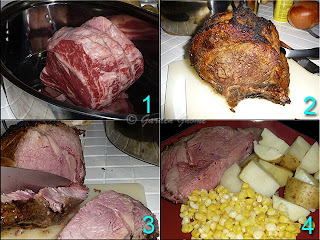If you have been following this blog you will know my husband and I hold special cooking contests called He Said/She Said. This month's contest (announced here) was for each of us to find one ingredient we had not cooked with then use that ingredient to make 2 dishes/recipes. That sounds simple doesn't it, but trust me it is a bit more challenging than it first appears.
I decided to follow my husband's approach of KISS (keep it simple silly). What I did was modify a tried and true recipe to create a new flavour for a lovely dessert to take to a friend's. Now here is where I cheated just a little as I didn't make two stand alone dishes but the cake could be finished using another method and the icing I created could also be used as a topping for other desserts. So technically I used the coconut milk in two ways for this contest.
 White Cake
White Cake
The beauty of my favourite basic white cake recipe is it can easily be modified. What I wanted to create was a cake that wasn't overly sweet yet moist and flavourful. I wanted it to be a little bit different. The recipe calls for ¾ cup of milk so I decided to substitute coconut milk instead. Coconut milk is not the thin watery liquid found inside a coconut but rather it is a sweet, milky white cooking base that is derived from the meat of mature coconuts. Canned coconut milk can be found in most larger grocery stores. If you cannot find coconut milk you can make it yourself by soaking grated coconut in hot water or milk to extract the oil and aromatic compounds then straining. Coconut milk has a fat content of approximately 17%. It should not be left at room temperature as coconut milk spoils quickly so always refrigerate.
Using coconut milk as a substitute in the white cake mixture resulted in a richer flavour and moister testure than the plain white cake. This comes from the higher fat content of the coconut milk. While the cake was baking and cooling I set about looking for an icing thinking something lightly flavoured with pineapple would be nice but then looking at the half can of left over coconut milk I came up with another idea that would give me the not too sweet result I was after.
 Coconut White Cake
Coconut White Cake
While I was searching for a topping that would use the rest of the coconut milk I came across a site that said coconut milk could be whipped to use as a replacement for whipping cream for those who can't or don't eat dairy. I decided to test this out and see what I could come up with. I placed the cold coconut milk in the bowl of the KitchenAid® stand mixer. Using the whisk attachment I beat on setting 10 for 3 minutes. The coconut milk did thicken somewhat but not to the same degree that heavy whipping cream does. In comparing the stiffness of the peaks after whipping, meringue is stiffer than heavy whipping cream which is stiffer than coconut cream. The problem was I wanted a topping with a bit more body. The first two additions that came to mind was gelatin and xanthum gum. Xanthun gum is a polysaccharide food additive used as a thickener. It is produced by fermenting glucose or sucrose by the Xanthomaonas campestris bacterium. , gluten free . Xanthan gum is gluten free so is a popular thickener for those on gluten free diets. It is also the ideal thickener for salad dressings. I thought xanthan gum would be quicker and easier so I used that. The main trick when using xanthan gum is using a blender or whisking at high speed while incorporating it into the mixture. I used about one eighth tsp of xanthan gum adding while whisking on speed 10. This gave the whipped coconut milk a nicer body. Then I spread the frosting over the cake and garnished with sweetened flaked coconut. I think it came out quite nice and it did get 2 thumbs up from our friends.
Note: This cake needs to be refrigerated because of the topping.






 Sautéed Brussels Sprouts
Sautéed Brussels Sprouts
 Three Meat Meatloaf
Three Meat Meatloaf Bacon Wrapped Turkey Rounds
Bacon Wrapped Turkey Rounds

 Pork Loin Chops
Pork Loin Chops Browning
Browning The Meal
The Meal Mystery
Mystery Cooked
Cooked Creamed Turkey Casserole
Creamed Turkey Casserole Turkey Stock
Turkey Stock Roast Turkey
Roast Turkey Apple Pie
Apple Pie Fresh Corn
Fresh Corn Husking Corn
Husking Corn Corn Chowder
Corn Chowder  Cedar Valley Cheese Store
Cedar Valley Cheese Store Cabela's
Cabela's Seasonings, Sauces & More
Seasonings, Sauces & More Commercial Grade Dehydrator
Commercial Grade Dehydrator Bayou Classic®
Bayou Classic® The Firefly Buffet
The Firefly Buffet Sculptures & More
Sculptures & More Crab Legs
Crab Legs Papa Murphy's
Papa Murphy's Mediterranean & Cheese Pizzas
Mediterranean & Cheese Pizzas
 Pressure Cooker Pulled Pork
Pressure Cooker Pulled Pork Le Gourmet Chef
Le Gourmet Chef Purchases
Purchases